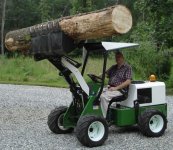""Lower air pressure will give a softer ride, but may also contribute to tire roll off.""
That is why I said: " 11# has worked well. Enough air to prevent tire, or wheel, damage, but soft enough for a full footprint, to absorb shocks, and to provide a gentle ride when loaded or unloaded. ". Less than 11# can cause tire damage including that described by JJ. 11# seems to be the best compromise to prevent damage from both overly soft and overly hard tires on the Front of the PT-425.
'''The advertised tire pressure for a certain tire is the pressure for the maximum load.'''
True, but you seldom use maximum tire pressures. The advertised tire pressure is the maximum load allowed on the tire, not the maximum load allowed on the vehicle. With the OEM tires on my wife's Azera, Azera calls for 30#, far below the maximum tire pressure of 51# listed for that tire. At 51# each tire could carry a load of 1653#, but that would be excessive for a 3600# car, and would cause the car to ride and handle terribly, while possibly leading to suspension damage. On that car 30# provides the best ride and handling while protecting both the tire and the suspension. When I first bought my PT, I asked PT what the best tire pressures would be, but they didn't have a clue! So, as usual with my PT, it was 'do it yourself' time!
""The tire pressures that Fourteen published is for a PT-425.""
True, but the same proceedure could be used to find the best pressures for any model PT.
PS: Note the tire profiles in this full load picture. (Also my handy 'saw holder'!!)
.
